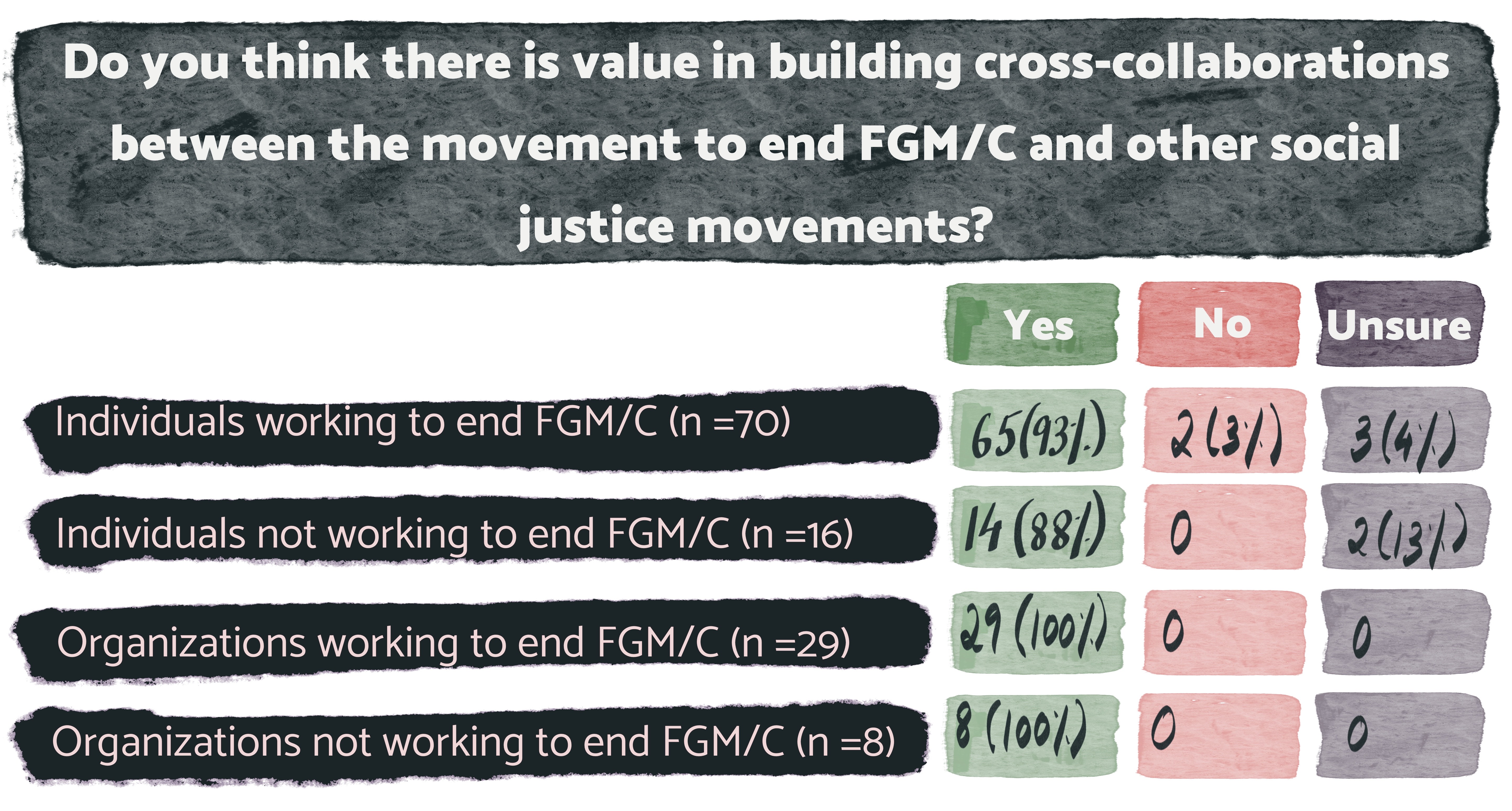Examining Intersections Between Female Genital Mutilation/Cutting And Social Oppressions: A Mixed Methods Study
NEWEST REPORT
Examining Intersections Between Female Genital Mutilation/Cutting And Social Oppressions: A Mixed Methods Study is the second report in the Critical Intersections Research Project; it focuses on the results of a mixed-methods survey distributed to over 100 participants.
Research findings reinforce themes from our initial report and add new intersections to the conversation.
The report is divided into three sections:

The body of work also includes recommendations for cross-sector collaboration that can uplift the larger themes of inequity at play and intersectional work involving the mission to end female genital mutilation/cutting (FGM/C):
- Ensure resources, terminology, and information on and about FGM/C is accessible, equitable, and does not reinforce unequal systems of power.
- Implement programming that addresses the intersectional needs of survivors from diverse backgrounds.
- Create opportunities for building a foundation to support crosscollaboration across social justice movements, including introductory activities, education initiatives, and training programs, before seeking cross-collaboration with other social justice movements and cross-sector funding.
- Initiate and facilitate brainstorming sessions for legitimate opportunities for synergistic collaboration led by intersectional organizations.
- Uplift more equitable systems of funding that prioritize community based organizations working with practicing communities, using a bottom-up approach.
- Consider the nuance of geographic location, particularly in regard to local laws and cultural acceptability of various social justice issues when seeking potential partnerships and crosscollaboration.
- Recognize the strength of diverse approaches to framing FGM/C, as opposed to the exclusive use of a single label, for anti-FGM/C work and collaborations with other movements.
- Consider interpersonal challenges, including discrimination within practicing communities, when framing the topic with survivors and generating approaches to ending FGM/C.
HISTORY
In 2022, Sahiyo initiated the Critical Intersections Research Project based on a popular 2021 webinar Critical Intersections: AntiRacism and Female Genital Mutilation/ Cutting (FGM/C)
The webinar examined the effects of racism on FGM/C survivors and the movement to end FGM/C. This expanded research project similarly seeks this topic with the following questions:
Upon initiating this project, Sahiyo discovered that in addition to systemic racism, several other factors of the human experience intersect with FGM/C to tell a larger story of critical intersections. Our initial project aims expanded to include:
Examining the Current State of Critical Intersections: Female Genital Mutilation/Cutting and Social Oppressions
Identifying current understandings of critical factors intersecting with female genital mutilation/cutting (FGM/C) is helpful to be able to both outline the gaps in our knowledge and understand how they impact the work being done to end FGM/C globally. This body of work, which is the first initiative of the Critical Intersections Research Project, established an important foundation for further exploration of the topic and has informed the creation of our subsequent quantitative and qualitative research.
Sahiyo compiled an extensive body of works on the topic of oppressions intersecting with FGM/C, including peer-reviewed literature, editorials, opinion pieces, reviews, and social media communications, to better understand how intersectionality comes across within the movement to end FGM/C. From this review, we produced a set of themes commonly found when it comes to discussions around FGC and intersectionality.
The report is organized around seven core themes that intersect with FGM/C and interact with each other to create a complex picture:

“... religion is often misused in regards to FGM/C… as a weapon against survivors… and almost protecting those committing this harm”
-Sameera Qureshi, Sahiyo’s Religion and FGC Panel
“Not knowing what happened to my body at such a young age led to a dissonance between body and being. If I can't even understand what my body went through, how do I gain a sense of bodily autonomy?”
- Saza Faradilla, personal communication, November 2022
” …rather than to begin with women’s sexual liberation, which played a prominent part in Western second-wave feminist agenda, African feminists have approached FGC by strengthening women’s social, economic, and political standing in society in order to give women themselves the weapons to fight FGC.”
- Emmaleena Käkelä, Rethinking Female Genital Cutting: From a Culturalist to a Structuralist Framework for Challenging Violence Against Women
“... in certain communities, there is an inherent, underlying racism that separates so-called ‘African FGM/C’ from ‘Asian’ or ‘other medicalized FGM/C’... we see that as a way to justify the ‘least severe forms’ of FGM/C…”
- Mariya Taher, Law, Justice and Development Webinar, World Bank
“I realized that female genital mutilation is not just about maintaining sexual abstinence but also ensuring that I conform to cis-heteronormative standards of femininity. ”
- Dena Igusti, “She/They” – On Being a Non-Binary Survivor of Female Genital Mutilation
“In a country with deep cultural ties to FGM and no ban on the practice, law enforcement has no place, and officers are afraid to intervene… they can’t enforce what does not exist. Critical attention must be given to raising awareness and engaging men and boys in the conversation around FGM”
-Dr. Nina Smart, personal communication, November 2022
“There's nothing that is being done at the moment. Very little, just a conversation at the global level, that is slightly prevalent at the national level, and there's nothing at the community level. It is still a theory. And these people are not yet connecting the dots between climate change and all the other impacts. And I am here as a front-line advocate, but I do not really understand the full degree of climate change and how we can mitigate it.”
- Domtila Chesang, personal communication, December 2022
